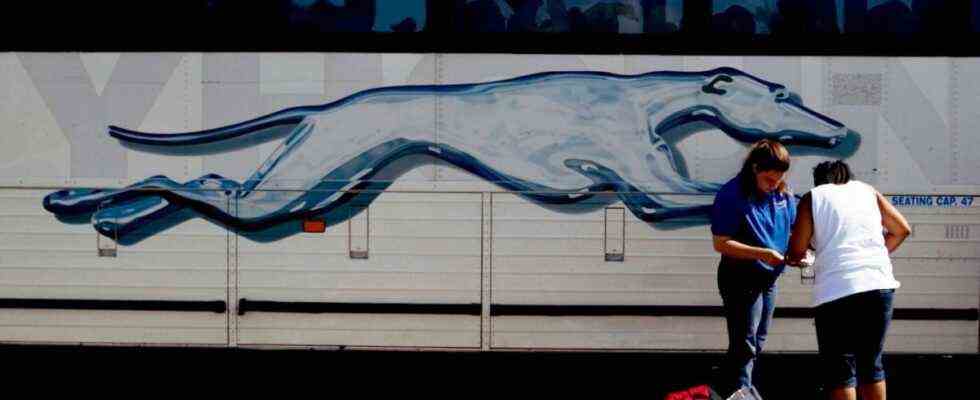Greyhound is a symbol of the vast America. The large, meanwhile blue intercity buses, with a greyhound as a logo on the outside, still stand for many of them American way of life – like other McDonald’s or Coca-Cola. Simon & Garfunkel once sang about a trip in a greyhound through the country in their world hit “America” in search of the real America. The intercity buses, notorious for smelly toilets, unconventional fellow travelers and unfriendly service, also played a role again and again in the cinema.
The bus company, based in Dallas in the US state of Texas, has experienced many ups and downs in its more than 100-year history, most recently the corona pandemic caused serious problems. But now a start-up from Munich is buying the company with the legendary name and wants to make it big again. Flixmobility announced this Thursday that the largest long-distance bus operator in the USA was taken over from the British rail and local transport company First Group for $ 172 million, the equivalent of 148 million euros. The company operates the Flixbus network in Germany and other European countries and is also on the move with Fixtrain on selected rail lines. Since the start of the first green Flix bus in 2013, a comprehensive network has been successfully established.
The green Flixbuses are now on the road in Germany and all of Europe and compete with the railways with cheap tickets.
(Photo: FREDERICK M. BROWN / AFP)
“Together, Flixbus and Greyhound will meet the increased demand for environmentally friendly mobility in the USA,” said Flixmobility co-founder André Schwämmlein. It remains to be seen whether this will also succeed so quickly in the USA. Because unlike in Europe, the routes there are longer, the roads are worse and people are even more focused on their own cars or on air travel. There, as well as in Canada and Mexico, there are currently around 1,300 greyhound buses that, according to Flixmobility, go to 2,400 destinations in North America and are used by 16 million passengers per year. Flixmobility has been on the road with its Flixbus brand in the USA since 2018 and restarted operations there in early summer after the pandemic. The aim is to become the market leader in the USA through the takeover.
Founded Flixbus with two partners and is now CEO: André Schwämmlein.
(Photo: Sophia Kembowski / dpa)
Flixbus carried 62 million passengers worldwide before Corona in 2019, and competitors were repeatedly bought up. The pandemic had brought the travel business almost completely to a standstill at times, the buses did not run at all for a long time, but the people of Munich got through the crisis thanks to financial reserves. In Germany, Flixmobility has been by far the market leader in the long-distance bus market for years. Flixbus is primarily an online platform, the green buses are operated on behalf of medium-sized companies, Flixbus arranges the travelers. The company is largely owned by financial investors, including from the USA, who recently made new capital available for expansion – some of which is now being invested in the USA.
Greyhound was founded by a Swedish immigrant
The Greyhound story began with the Swedish immigrant Carl Eric Wickman. He was a worker in an ore mine and was laid off in 1914. Together with two other Swedes he set up a car dealership, but business went badly, and Wickman was left with the car. Underneath was a seven-seater minibus. In an emergency, he then changed his business model and set up a ride-sharing service for miners in 1914. Soon he was selling the tickets to everyone. In 1918 his “Mesaba Transportation Company” already owned 18 buses. For the advertisement, Wickman came up with the slogan: The Greyhounds of the Highway – so the greyhounds of the country road. In 1929 the company was renamed the Greyhound Corporation.
Wickman died in 1954 at the age of 67, after which the company began to decline. In the USA, a network of highways was built along the lines of German autobahns, and driving became easier and cheaper. Those who could afford it switched. The bus soon became a means of transport for those who couldn’t afford a car. The owners changed several times, in 2001 the end was almost imminent, but it went on and on. In 2007, First Group from Scotland took over Greyhound’s parent company for nearly $ 3.5 billion at the time. At first they were only interested in the huge school bus business, but then they also invested in Greyhound intercity buses. So now the Scots are selling to the Germans.
Business didn’t always go well: a Greyhound bus destined for Los Angeles in 1995.
(Photo: Peer Körner / dpa)
Most recently, Greyhound sales were $ 423 million a year, according to previous owner First Group, and operating profit was only a minimal $ 1.8 million. Flixmobility will initially pay around $ 140 million for the company, with $ 32 million expected to flow in installments over the next 18 months. Greyhound’s real estate, such as the bus terminals, will remain in the possession of the First Group; they are only rented by Flixbus. The state grants of 108 million dollars that Greyhound received from the US government to compensate for the pandemic-related losses, however, will remain with Greyhound and thus benefit Flixmobility.

